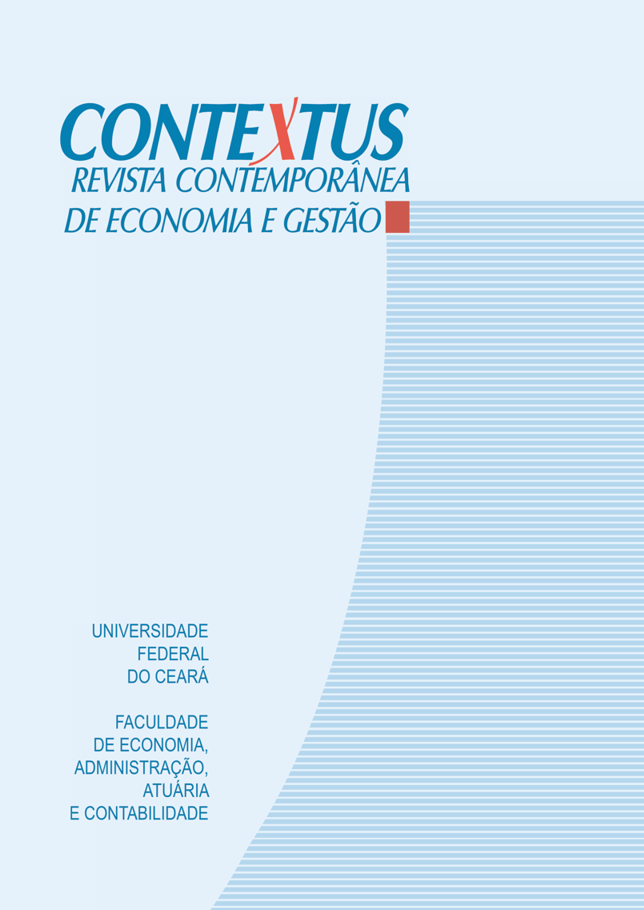Luxury Brands: Awareness and image and its influence on loyalty and engagement
DOI:
https://doi.org/10.19094/contextus.2021.71415Keywords:
luxury brands;, brand awareness;, brand image;, brand loyalty;, engagement.Abstract
This work is based on the concept of Brand Equity in the luxury sector. It analyzes the relationships between Awareness, Image and Loyaty, including Engagement in its relationship with commented variables. A theoretical model was specified and tested by Confirmatory Factor Analysis. Hypothesis have been tested running a structural equations model. Each hypothesis has resulted to be significant. The model had a good fit to the data. The conclusions obtained from the analysis of the data allow us to describe the effects that occur between the variables, being important for their management so that managers of the luxury companies can increase the value of their brands.
Downloads
References
Aaker, D. (1991). Managing brand equity: Capitalizing on the value of a brand name. New York: The Free Press.
Aaker, D. (1996). Measuring brand equity across products and markets. California Management Review, 38(3), 102-120. https://doi.org/10.2307/41165845
Aberdeen, N. I., Syamsum, M., & Najib, M. (2016). The effect of brand awareness and image on consumer perceived quality and purchase intention – A study case of carbonated drink brand at Bogor City. International Journal of Scientific and Research Publications, 6(8), 441-446.
Ajzen, I. (1991). The theory of planned behavior. Organizational Behavior and Human Decision Processes, 50(2), 179-211. https://doi.org/10.1016/0749-5978(91)90020-T
Andreassen, T., & Lindestand, B. (1998). Customer loyalty and complex services: The impact of corporate image on quality, customer satisfaction and loyalty for customer with varying degrees of service expertise. International Journal of Service Industry Management, 9, 7-23. https://doi.org/10.1108/09564239810199923
Auh, S., Bell, S., McLeod, C., & Shih, E. (2007). Co-production and customer loyalty in financial services. Journal of Retailing, 83, 359-370. https://doi.org/ 10.1016/j.jretai.2007.03.001
Baldinger, A. L., & Rubinson, J. (1996). Brand loyalty: The link between attitude and behavior. Journal of Advertising Research, 36(2), 22-36.
Banyte, J., & Dovaliene, A. (2014). Relations between customer engagement into value creation and customer loyalty. Social and Behavioral Sciences, 156, 484-489. https://doi.org/ 10.1016/j.sbspro.2014.11.226
Berthon, P., Pitt, L., Parent, M., & Berthon, J. (2009). Aesthetics and ephemerality: Observing and preserving the luxury brand. Business Horizons, 1, 45-66.
https://doi.org/ 10.1525/cmr.2009.52.1.45
Bilgin, Y. (2018). The effect of social media marketing activities on brand awareness, brand image and brand loyalty. Business & Management Studies: An International Journal, 6(1), 128-148. https://doi.org/10.15295/bmij.v6i1.229
Blasco, L., Hernandez, B., & Jimenez, J. (2011). Co-creation processes and engagement: An empirical approach. In E. Gummesson, C. Mele & F. Polese (Eds.). Service dominant logic, network & systems theory and service science. Giannini: Napoli.
Boo, S., Busser, J., & Baloghu, S. (2008). A Model of customer-based brand equity and its application to multiple destinations. Tourism Management, 30, 219-231. https:/doi.org/10.1016/j.tourman.2008.06.003
Bowden, J. (2009). The process of customer engagement: A conceptual framework. Journal of Marketing Theory and Practice, 1, 63-74.
https://doi.org/10.2753/MTP1069-6679170105
Brodie, R., Hollebeek, L., Jurić, B., & Ilić, A. (2011). Customer engagement: Conceptual domain, fundamental proposition, and implications for research. Journal of Service Research, 3, 252-271. https://doi.org/10.1016/j.jbusres.2011.07.029
Buil, I., De Chernatony, L., & Martinez, E. (2013). La importancia de medir el valor de marca desde la perspectiva del consumidor: Evidencia empírica en España y Reino Unido. Revista de Ciencias Sociales, 2, 226-237.
Cambra, J., Melero, I., & Sese, J. (2012). Aproximación al concepto de engagement: Un estudio exploratorio en el sector de la telefonía móvil, Universia Business Review, 33, 84-103.
Castaldo, S., Grosso, M., Mallarini, E., & Rindone, M. (2015). The missing path to gain customers loyalty in pharmacy retail: The role of the store in developing satisfaction and trust. Research in Social and Administrative Pharmacy, 12(5), 699-712. https://doi.org/10.1016/j.sapharm.2015.10.001
Chang, Y. H. (2012). A study on the marketing performance using social media - Comparison between portal advertisement, blog, and SNS channel characteristics and performance. Journal of Digital Policy & Management, 8(10), 119-133. https://doi.org/10.14400/JDPM.2012.10.8.119
Dhaoui, C. (2014). An empirical study of luxury brand marketing effectiveness and its impact on consumer engagement on Facebook. Journal of Global Fashion Marketing, 5(3), 209-233.
https://doi.org/10.1080/20932685.2014.907605
Ding, C., & Tseng, T. (2015). On the relationships among brand experience, hedonic emotions, and brand equity. European Journal of Marketing, 49, 994-1007.
https://doi.org/ 10.1108/EJM-04-2013-0200
Dubois, B., Laurent, G., & Czellar, S. (2001). Consumer rapport to luxury: Analyzing complex and ambivalent attitudes. Consumer Research, Working Paper, n. 736. France: HEC.
Farhat, K., Mokhtar, S. S. M., & Salleh, S. M. (2020). Linking brand engagement to customer-based brand equity and role of brand experience, brand personality, and brand affect: A case of automobile market of Pakistan, Management Science Letters, 10, 2237-2248. https://doi.org/10.5267/j.msl.2020.3.012
Farquhar, P. (1989). Managing brand equity. Marketing Research, 1, 24-33.
Finney, S. J., & Di Stefano, C. (2006). Non-normal and categorical data in SEM. In G. R. Hancock & R. O. Mueller (Eds.). Structural equation modelling: A second course. Greenwich, CO: Information Age Publishing.
Gallart-Camahort V., Callarisa-Fiol, L., & Sanchez-García, J. (2021). Influence of the internet on retailer’s perceived quality in the generation of retailer’s brand equity. Vision: The Journal of Business Perspective. https://doi.org/10.1177/0972262921992212
Gambetti, R. C., & Graffigna, G. (2010). The concept of engagement: A systematic analysis of the ongoing marketing debate. International Journal of Market Research, 52(6), 801-826.
https://doi.org/ 10.2501/S147078531020166
Gómez, M., Lopez, C., & Molina, A. (2019). An integrated model of social media brand engagement. Computers in Human Behavior, 96, 196-206.
https://doi.org/10.1016/j.chb.2019.01.026
Grassi, A. (2020). Art to enhance consumer engagement in the luxury fashion domain. Journal of Fashion Marketing and Management: An International Journal, 24(3), 327-341.
https://doi.org/10.1108/JFMM-09-2019-0194
Gremler, D. D., & S. W. Brown (1996). Service loyalty: Its nature, importance, and implications. In B. Edvardsson, S. W. Brown & R. Johnston (Eds.). Advancing service quality: A global perspective. New York: International Service Quality Association.
Greve, G. (2014). The moderating effect of customer engagement on the brand image – Brand loyalty relationship. Procedia - Social and Behavioral Sciences. 148, 203-210. https://doi.org/10.1016/j.sbspro.2014.07.035
Hagtvedt, H., & Patrick, V. (2009). The broad embrace of luxury: Hedonic potential as a driver of brand extendibility. Journal of Consumer Psychology, 4, 608-618. https://doi.org/ 10.1016/j.jcps.2009.05.007
Hanzaee, K., & Farsani, F. (2011). The effects of brand image and perceived public relation on customer loyalty. World Applied Sciences Journal, 2, 277-286.
Heine, K. (2012). The concept of luxury brands. Écully: Goldman & Vredenburgh. http://upmarkit.com/sites/default/files/content/20130403_Heine_The_Concept_of_Luxury_Brands.pdf
Higgins, T., & Scholer, A. (2009). Engaging the consumer: The science and art of the value creation process. Journal of Consumer Psychology, 2, 100-114. https://doi.org/ 10.1016/j.jcps.2009.02.002
Hollebeek, L. D. (2011). Exploring customer brand engagement: Definition and themes. Journal of Strategic Marketing, 19(7), 555-573. https://doi.org/10.1080/0267257X.2010.500132
Huang, R., & Sarigöllü, E. (2012). How brand awareness relates to market outcome, brand equity, and the marketing mix. Journal of Business Research, 65(1), 92-99. https://doi.org/10.1007/978-1-4939-0277-4_8
Ismail, A. R. (2015). Leveraging the potential of word of mouth: The role of love, excitement and image of fashion brands. Journal of Global Fashion Marketing, 6(2), 87-104. https://doi.org/10.1080/20932685.2014.999013
Jara, M., & Cliquet, G. (2007). Retail brand equity: A conceptual and differentiated approach. European Association of Education and Research in Commercial Distribution, Germany, 14. https://doi.org/10.1016/j.jretconser.2011.11.003
Johnson, M., Andreessen, T., Lervik, L., & Cha, J. (2001). The evolution and future of national customer satisfaction index models. Journal of Economic Psychology, 22, 217-245. https://doi.org/10.1016/S0167-4870(01)00030-7.
Jorgensen, F., Mathisen, T. A., & Pedersen, H. (2016). Brand loyalty among Norwegian car owners. Journal of Retailing and Consumer Services, 31, 256-264. https://doi.org/ 10.1016/j.jretconser.2016.04.001
Kapferer, J. (1997). Managing Luxury Brands. Journal of Brand Management, 4, 251-260.
Keller, K. (1993). Conceptualizing, measuring and managing customer-based brand equity. Journal of Marketing, 57, 1-22. https://doi.org/10.2307/1252054
Keller, K. L. (2003). Strategic brand management: Building, measuring, and managing brand equity. Upper Saddle River, NJ: Prentice-Hall.
Keller, K. (2009). Managing the growth tradeoff: Challenges and opportunities in luxury branding. Journal of Brand Management, 5, 290-301. https://doi.org/10.1007/978-3-319-51127-6_9
Kenny, D. A., Kaniskan, B., & McCoach, D. B. (2015). The performance of RMSEA in models with small degrees of freedom. Sociological Methods & Research, 44, 486-507. https://doi.org/ 10.1177/0049124114543236
Kim, A., & Ko, E. (2012). Do social media marketing activities enhace customer equity? An empirical study of luxury fashion brand. Journal of Business Research, 65, 1480-1486. https://doi.org/10.1016/j.jbusres.2011.10.014
Kim, H., & Kim, W. (2005). The relationship between brand equity and firms’ performances in luxury hotels and chain restaurants. Tourism Management, 26, 549-560. https://doi.org/10.1016/j.tourman.2004.03.010
Ko, E., Costello, J., & Taylor, C. (2017). What is luxury brand? A new definition and review of the literature. Journal of Business Research, 99, 405-413. https://doi.org/10.1016/j.jbusres.2017.08.023
Kotler, P. (2002). Marketing Management (Millennium Edition). Boston: Pearson Custom Publishing.
Kotler, P., & Keller, K. (2016). Dirección de Marketing. México: Pearson.
Kotsi, F., Pike, S., & Gottlieb, U. (2018). Consumer-based brand equity (CBBE) in the context of an international stopover destination: Perceptions of Dubai in France and Australia. Tourism Management, 69, 297-306https://doi.org/10.1016/j.tourman.2018.06.019
Kuvykaite, R., & Piligrimiene, Z. (2014). Consumer engagement into brand equity creation, Journal of Business Research, 156, 479-483. https://doi.org/10.1016/j.sbspro.2014.11.225
Lassar, W., Mittal, B., & Sharma, A. (1995). Measuring customer-based brand equity. Journal of Consumer Marketing, 12, 11-19. https://doi.org/10.1108/07363769510095270
Liu, G., Liston-Heyes, C., & Ko, W. W. (2010). Employee participation in cause-related marketing strategies: A study of management perceptions from British consumer service industries. Journal of Business Ethics, 92, 195-210. https://doi.org/10.1007/s10551-009-0148-3
Liu, M., Wong, A., Tseng, T., &Chang, A. (2017). Applying consumer-based brand equity in luxury hotel branding. Journal of Business Research, 81, 192-202. https://doi.org/10.1016/j.jbusres.2017.06.014
MacDonald, E., & Sharp, B. (2000). brand awareness effects on consumer decision making for a common, repeat purchase product: A replication. Journal of Business Research, 1, 5-15. https://doi.org/10.1016/S0148-2963(98)00070-8
Marsh, H. W., Hau, K. T., & Wen, Z. (2004). In search of golden rules: Comment on hypothesis-testing approaches to setting cutoff values for fit indexes and dangers in overgeneralizing Hu and Bentler’s (1999) findings. Structural Equation Modeling, 11, 320-341. https://doi.org/10.1207/s15328007sem1103_2
Martínez, P., Pérez, A., & Bosque, I. R. (2014). CSR influence on hotel brand image and loyalty. Academia Revista Latinoamericana de Administración, 27(2), 267-283. https://doi.org/10.1108/ARLA-12-2013-0190
Matos, C., & Rossi, C. (2008). Word-of-mouth communications in marketing: A meta-analytic review of the antecedents and moderators. Journal of the Academy of Marketing Science, 36, 578-596.
Musekiwa, A., Chiguvi, D., & Hogo, H. (2013). customer based retail brand equity (RBE) dimensions effect on retail brand equity for OK Supermarket in Bindura. International Center of Business and Management, 8, 45-54 https://doi.org/10.5539/ijbm.v8n19p45
Neff, J. (2007). OMD proves the power of engagement, Advertising Age, 78.
Nueno, J., & Quelch, J. (1998). The mass marketing of luxury. Business Horizons, 41(6), 61-68. https://doi.org/10.1016/S0007-6813(98)90023-4
Odin, Y., Odin, N., & Valette-Florence, P. (2001). Conceptual and operational aspects of brand loyalty: An empirical investigation. Journal of Business Research, 53(2), 7-84. https://doi.org/10.1016/S0148-2963(99)00076-4
Pansari, A. & Kumar, V. (2017). Customer engagement: the constructs, antecedents and consequences. Journal of the Academy of Marketing Science, 45(3), 294-311
. https://doi.org/10.1007/s11747-016-0485-6
Pappu, R., & Quester, P. (2006). Does consumer satisfaction lead to improved brand equity? An empirical examination of two categories of retail brands. Journal of Product & Brand Manangement, 15, 4-14. https://doi.org/10.1108/10610420610650837
Pappu, R., Quester, P., & Cooksey, R. (2006). Consumer-bassed brand equity and country-of-origin relationships. European Journal of Marketing, 40, 696-717. https://doi.org/10.1108/03090560610657903
Patterson, P., Ting, Y., & De Ruyter, K. (2006). Understanding customer engagement in services. Proceedings of ANZMAC Conference, Australia.
Prasad, K., & Dev, C. (2000). Managing hotel brand equity: A customer-centric framework for assessing performance. Cornell Hotel and Restaurant Administration Quarterly, 3, 22-31. https://doi.org/10.1016/S0010-8804(00)80014-2
Rajah, E., Marshall, R., & Nam, I. (2008). Relationship glue: Customers and marketers co-creating a purchase experience. Advances in Consumer Research, 35, 367-373.
Rahman, M. S., Hossain, M. A., Hoque, M. T., Rushan, M. R. I., & Rahman, M. I. (2020). Millennials’ purchasing behavior toward fashion clothing brands: Influence of brand awareness and brand schematicity. Journal of Fashion Marketing and Management: An International Journal, 25(1), 153-183. https://doi.org/10.1108/jfmm-07-2019-0137
Rappaport, S. (2007). Lessons from Online Practice: New Advertising Models. Journal of Advertising Research, 7, 135-141.
Rauyruen, P., & Miller, K.E. (2007). Relationship quality as a predictor of B2B customer loyalty. Journal of Business Research, 60(1), 21-31. https://doi.org/10.2501/S0021849907070158
Romaniuk, J., Wight, S., & Faulkner, M. (2017). Brand awareness: Revisiting an old metric for a new world. Journal of Product & Brand Management, 26(5), 469-476. https://doi.org/10.1108/JPBM-06-2016-1242
Sashi, C. (2012). Customer engagement, buyer-seller relationships, and social media. Management Decisions, 50, 253-272. https://doi.org/10.1108/00251741211203551
Sasmita, J., & Suki, N. M. (2015). Young consumers’ insights on brand equity effects of brand association, brand loyalty, brand awareness, and brand image. International Journal of Retail & Distribution Management, 43(3), 276-292. https://doi.org/10.1108/IJRDM-02-2014-0024
Schivinski, B., & Dabrowski, D. (2015). The impact of brand communication on brand equity through Facebook. Journal of Research in Interactive Marketing, 9, 31-53. https://doi.org/10.1108/JRIM-02-2014-0007
Seetharaman, A., Nadzir, Z. A. B. M., & Gunalan, S. (2001). A conceptual study on brand valuation. The Journal of Product and Brand Management, (10)4, 243-256. https://doi.org/10.1108/EUM0000000005674
Shamma, H., & Hassan, S. (2011). Integrating product and corporate brand equity into total brand equity measurement. International Journal of Marketing Studies, 3, 11-20.
Sprott, D., Czellar, S., & Spangenberg, E. (2009). The importance of a general measure of brand engagement on market behavior: Development and validation of a scale. Journal of Marketing Research, 46, 92-104. https://doi.org/10.1509/jmkr.46.1.92
Sürücü, Ö., Öztürk, Y., Okumus, F., & Bilghan, A. (2019). Brand awareness, image, physical quality and employee behavior as building blocks of customer-based brand equity: Consequences in the hotel contexto. Journal of Hospitality and Tourism Management, 40, 114-124. https://doi.org/10.1016/J.JHTM.2019.07.002
Sweeney, J., & Soutar, G. (2001). Consumer perceived value: The development of a multiple item scale. Journal of Retailing, 77, 203-220. https://doi.org/10.1016/S0022-4359(01)00041-0
Switala, M., Gamrot, W., Reformat, B., & Bilinska-Reformat, K. (2018). The influence of brand awareness and brand image on brand equity – an empirical study of logistics service providers. Journal of Economics and Management, 33(3), 97-119. https://doi.org/10.22367/jem.2018.33.06
Swoboda, B., Berg, B., Schramm-Klein, H., & Foscht, T. (2013). The importance of retail brand equit and store accessibility for store loyalty in local competition. Journal of Retailing and Consumer Services, 20, 251-262. https://doi.org/10.1016/j.jretconser.2013.01.011
Tybout, A., & Artz, N. (1994). Consumer Psychology. Annual Review of Psychology, 45, 131-169. https://doi.org/10.1146/annurev.ps.45.020194.001023
Van Doorn, J., Lemon, K., Mittal, V., Nass, S., Pick, D., Pirner, P., & Verhoef, P. (2010). Customer engagement behavior: Theoretical foundations and research directions. Journal of Service Research, 3, 253-266. https://doi.org/10.1177/1094670510375599
Vigneron, F., & Johnson, L. (2004). Measuring brand luxury perceptions. The Journal of Brand Management, 11, 484-508.
Voyles, B. (2007). Beyond loyalty: Meeting the challenge of customer engagement. London: Economist Intelligence Unit.
Wood, L. (2000). Brands and brand equity: Definition and management. Management Decision, 38(9), 662-669. https://doi.org/10.1108/00251740010379100
Wu, W. Y., Do, T. Y., Nguyen, P. T., Anridho, N., & Vu, M. Q. (2020). An integrated framework of customer-based brand equity and theory of planned behavior: A meta-analysis approach. Journal of Asian Finance Economics and Business, 7(8), 371-381. https://doi.org/10.13106/jafeb.2020.vol7.no8.371
Xi, N., & Hamari, J. (2020). Does gamification affect brand engagement and equity? A study in online brand communities. Journal of Business Research, 109, 449-460. https://doi.org/10.1016/j.jbusres.2019.11.058
Yoo, B., Donthu, N., & Lee, S. (2000). An examination of selected marketing mix elements and brand equity. Journal of Marketing Research, 21, 799-822.
https://doi.org/ 10.1177/0092070300282002
Published
How to Cite
Issue
Section
License
The authors, while doing the submission, accept the notice below:
We authors hold the copyright related to our paper and transfer Contextus journal the right for the first publication with a Creative Commons’ international license of the modality Attribution – Non-commercial 4.0, which in turn allows the paper to be shared providing that both the authorship and the journal’s right for initial release are acknowledged.
Furthermore, we are aware of our permission to take part in additional contracts independently for non-exclusive distribution of the version of our work published in this journal (e.g. publishing it in an institutional repository or as a book chapter), while acknowledging both the authorship and the journal’s initial publication.
We also certify that the paper is original and up to this date has not been released in any other journal, Brazilian or of another nationality, either in Portuguese or another language, as well as it has not been sent for simultaneous publication in other journals.
Last, we not only know that plagiarism is not tolerated by Contextus but also certify the paper presents the sources of passages from cited works, including those authored by ourselves.









3.png)


1.jpg)



1.jpg)


1.jpg)






.jpg)



1.jpg)

1.jpg)


1.jpg)

1.jpg)
1.jpg)
2.png)




1.jpg)
2.jpg)

1.jpg)





1.jpg)


1.jpg)
1.jpg)
